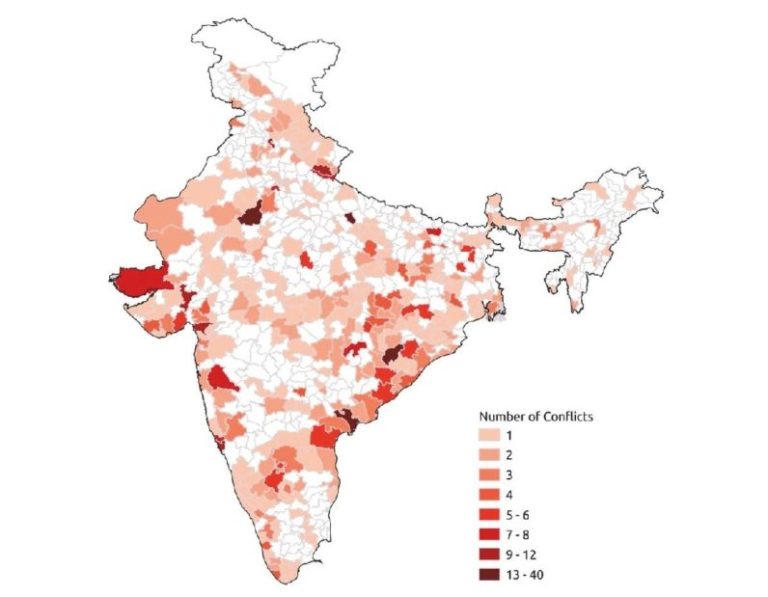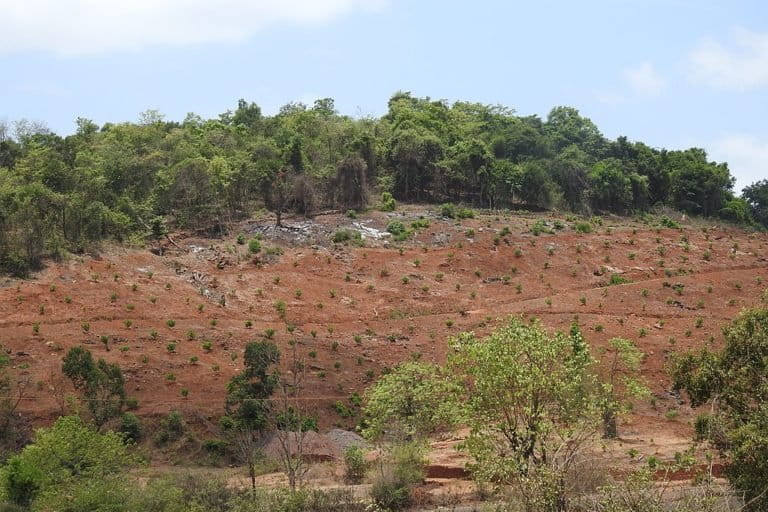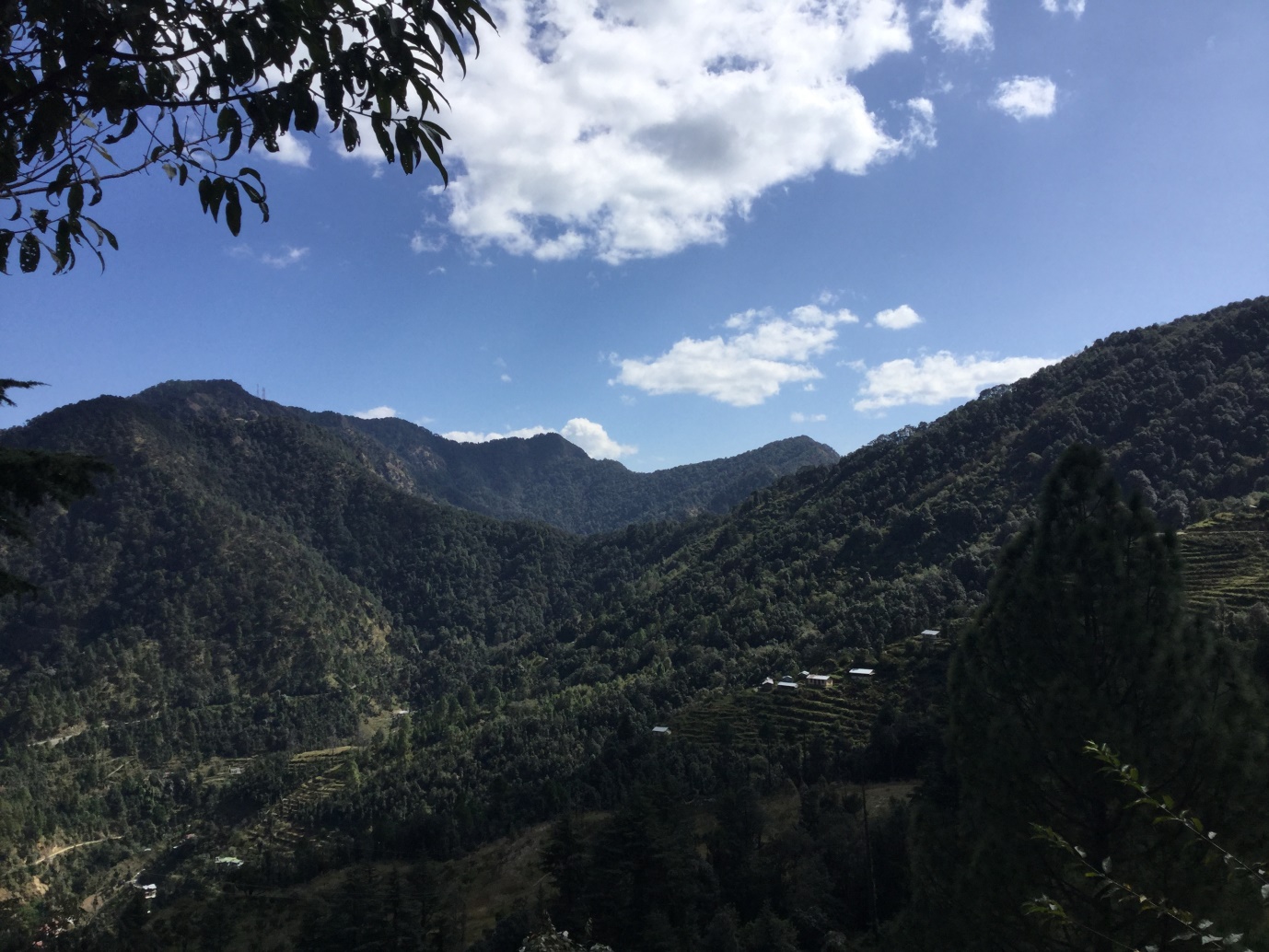
In India, on average, at least 10,600 people are impacted by each ongoing land conflict. The number crosses 21,300 in the land conflicts involving mining projects, reveals a recent study released last month.
The study revealed that investments worth about Rs 13.7 trillion (Rs 13.7 lakh crore) were found embroiled in 335 of the 703 ongoing land conflicts, which is equivalent to about 7.2 percent of the revised estimate of India’s Gross Domestic Product (GDP) for 2018–19.
The study, ‘Locating the Breach’ released by the Land Conflict Watch (LCW), a New Delhi-based research group, reveals where and why land conflicts are occurring in the country. The report, based on three years of research, stresses on how land conflicts are affecting different sections of society and several segments of business and economy.
It highlighted that over 2.1 million (21 lakh) hectares of land is locked in land conflicts that were categorised into six broad sectors – infrastructure, power, conservation and forestry, land use, mining, and industry. Of those, infrastructure-related conflicts are spread over the largest area, about 1.56 million hectares, which is almost equal to the area of Nagaland.
As per the study, infrastructural development (townships and real estate schemes, roads and irrigation projects etc ) and mining projects are responsible for about 50 percent of the total land conflicts with 43 and six percent conflicts respectively. Conservation and forestry-related activities such as compensatory afforestation plantations and wildlife conservation schemes account for 15 percent of the conflicts.
The report stressed that an estimated 6.5 million people have been impacted by the 703 land conflicts analysed in the report. Of those, land conflicts caused by infrastructure projects affect more than three million people with each infrastructure project caught in a land conflict impacts the lives of 12,354 people, on average. Mining related land conflicts have the second-biggest impact, affecting 852,488 citizens.
Of the total investments worth about Rs 13.7 trillion embroiled in the conflicts, infrastructure-related conflicts involve investments worth over Rs seven trillion (Rs seven lakh crore) followed by power-and industry-related conflicts that affect Rs 2.8 trillion (Rs 2.8 lakh crore) and Rs 2.7 trillion (Rs 2.7 lakh crore) of investments, respectively.
Another interesting data highlighted in the study is that of the 703 cases, in 667 (95 percent) cases, the “state (government) comprised the second party in the conflict.” The report said that in these 667 cases, government agencies or public sector undertakings are interested parties either as project promoters or as mediators of the conflict as regulators.
“In 188 cases (27 percent), private companies or businesses are involved in the conflict. In 23 ( three percent) cases, the conflicts are between different communities,” the report said.

“India has an array of laws to recognise the traditional land rights of people and to facilitate equitable sharing of land resources. But a large number of land conflicts are still jeopardising human rights of people and huge investments,” Kumar Sambhav Shrivastava, co-founder of the LCW and one of the co-authors of the study, told Mongabay-India.
Majority of land conflicts involve “common lands”
The LCW report highlighted that the majority of land conflicts across the country involve common lands.
“In most cases involving common lands, as opposed to private lands, citizens do not own private individual titles to these lands. The title, control, and ownership over these lands can be held collectively by communities, villages, municipal authorities, different levels of local elected bodies, and/or state governments. While the government defines many types of common lands as “wastelands”, most of these common lands are heavily used by citizens, particularly those from the marginal communities. Communities and citizens often have either state recognised or traditional rights over these commons,” said the report.
As per the report, 36 percent of the conflicts were exclusively about common lands, 29 percent of land conflicts involved only private lands, and the remaining 32 percent of the conflicts involved both common and private lands.
Tribal dominated areas are a hotbed for mining conflicts
The LCW report also looked at the nature of land conflicts in tribal-dominated Fifth Schedule Areas (of the Indian Constitution) with relatively higher levels of economic backwardness.
The Indian Constitution provides special administrative dispensation for areas marked under “Scheduled Areas” and right now, according to the government of India, these areas are in 100 districts across 10 states. These states are Andhra Pradesh, Jharkhand, Chhattisgarh, Himachal Pradesh, Madhya Pradesh, Gujarat, Maharashtra, Odisha, Rajasthan, and Telangana.
According to the LCW report, there were a total of 182 conflicts in fifth schedule districts which is about 1/4th of the total conflicts. It also said that these districts had higher incidences of mining conflicts as about 60 percent of all mining conflicts are in the fifth scheduled districts.
The report also analysed conflicts that involved forest land and found 272 conflicts. According to the report, of the 272 eligible conflicts, 131 included the violation or non-implementation of the Forest Rights Act (FRA) 2006 as a cause of conflict.
These comprised 48 percent of all conflicts involving forests and 18.6 percent of all 703 documented conflict cases. A total of 1.2 million (12 lakh) people have been impacted by conflicts involving the FRA, on a total land area of 368,138 hectares.
Creation of land banks is another major threat
The report discussed that several state governments in India began creating land banks in the 1990s. It stressed that land banks create avenues for the immediate diversion of land to private investors, bypassing lengthy bureaucratic processes such as those under the land acquisition laws.
The report highlighted that “according to state government websites, up to 2.68 million (26.8 lakh) hectares of land – an area larger than the state of Meghalaya – has been set aside for land banks in eight states.” These eight states are Andhra Pradesh, Chhattisgarh, Jharkhand, Madhya Pradesh, Odisha, Rajasthan, Tamil Nadu, and Uttar Pradesh.

“Most Indian states either already have sizable land banks or are in the process of creating them. However, only the eight aforementioned states have provided details regarding them in the public domain as of September 2017,” the report said.
The LCW report stated that the strategy to have land parcels free of encumbrances readily available for prospective projects may sound rational, but land banks also act as a bypass mechanism to deny the rights of communities.
It noted that there are cases where conflicts were caused by the creation of land banks. In those cases, the report said, that the land was initially allotted for industrial and infrastructure projects but when these projects were shelved due to local opposition, the state hoarded these lands for itself.
“LCW’s data shows that these lands were predominantly common lands or forests to which communities had traditional rights. Instead of giving conflicted lands back to the people and to the communities who had opposed these projects, states have banked these lands, locking it away for potential future use. In most cases, the initial conflict was never resolved,” said the report.
The report emphasised that this practice generates grave issues for communities that lose their livelihoods, connection, and physical possession over the lands.
“There is also the potential risk of future investments on banked lands facing conflicts similar to those that prevented the previously planned projects. In addition to the industry, the government has now started banking land even for the plantations under the compensatory afforestation scheme. In many cases, common lands over which communities had traditional rights have been set aside as part of land banks,” said the report.
It explained that such lands are often targeted for creating land banks because citizens do not have clear titles over them and once the land is banked, it becomes even more difficult for communities to claim rights over it under laws such as the FRA.
Shrivastava from LCW stressed that the data clearly shows that “progressive laws like the FRA and the LARR (Land Acquisition, Rehabilitation and Resettlement Act) are not being implemented in letter and spirit.”
“This has clearly reflected in our data. Over two-third of the conflicts are related to the use of common lands. The government is failing to recognise the traditional rights of communities over such lands. Often there is also a false narrative propagated that the requirement of consent in the FRA and the LARR, delays the project. Our data analysis shows that it is not the requirement of the consent but the violation or sidelining the consent provisions that cause conflicts and locks up the project’s investments,” he said.
Dalits still can’t own land
The report highlighted that the Dalits (members of the scheduled castes as listed in the Indian Constitution), which form the largest landless social group in the country, are still not able to own land.

According to the India Land and Livestock Holding Survey, almost 60 percent of Dalit households did not own any farmland in 2013 and that land ownership is substantially lower in this group compared to scheduled tribes, other backward classes, and general category households.
It is a significant issue because landlessness among Dalits has deep roots as the ancient caste system practiced in India banned them from owning land, which forced them to do jobs determined by their caste and their status as “untouchables”.
Since Independence, the authorities have tried to introduce land reforms but they have not able to deliver. The LCW report showed that Dalits continue to be excluded from owning property, an issue that greatly contributes to inequality and land conflicts across India.
LCW documented 31 ongoing conflicts involving at least 92,000 Dalits in 13 states. “The conflicts cover a total area of 39,400 hectares – equivalent to the area of Chennai city. The states where these conflicts were reported, such as Punjab, Bihar, Gujarat, Maharashtra, and Kerala lie at dramatically varying ends of social and economic parameters but are united by their poor implementation of land reforms and a high incidence of landlessness among Dalits,” said the report.
Vincent Manoharan, who is the chairperson of the National Federation of Dalit Land Rights Movements (NFDLRM), told Mongabay-India that the study is an eye-opener for the policymakers, legislators, bureaucrats, academics, researchers, campaigners and land right movement leaders to analyse and scrutinise the current development policy of India and land governance as a whole.
“This report warrants all actors to look at land with a different perception, as to how it affects people at large, whose life and livelihood is based on land. The land has been viewed as a commodity by the development sector, but that is the base for the dignity and identity of Dalits. India is still known as an agricultural country, but the agricultural sector and Dalits who put their sweat and labour are side-lined and ignored,” said Manoharan.
He stressed that the NFDLRM will use the study to mobilise Dalit peasants and agricultural labourers to intensify their struggles to check this ongoing trend, which is detrimental to the very life and livelihood of Dalits.
This article is republished from The Mongabay under a Creative Commons license. Read the original article.













